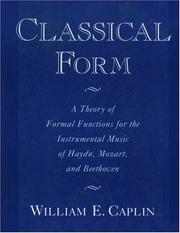Check nearby libraries
Buy this book

When we listen to a Mozart piano sonata or a Haydn symphony, how do we know where we are from one moment to the next? How can we tell what parts of the piece belong to one another, or where the boundaries are? These are the questions raised and answered in William Caplin's Classical Form: A Theory of Formal Functions for the Instrumental Music of Haydn, Mozart, and Beethoven.
Check nearby libraries
Buy this book

Previews available in: English
Subjects
Criticism and interpretation, Analysis, appreciation, Instrumental music, Music theory, History, Musical analysis, Musical form, Classicism in music, Music, history and criticism, Instrumental music, history and criticism, Haydn, joseph, 1732-1809, Mozart, wolfgang amadeus, 1756-1791, Beethoven, ludwig van, 1770-1827, Music, ClassicalPeople
Joseph Haydn (1732-1809), Wolfgang Amadeus Mozart (1756-1791), Ludwig van Beethoven (1770-1827)Times
19th century, 18th century| Edition | Availability |
|---|---|
|
1
Classical form: a theory of formal functions for the instrumental music of Haydn, Mozart, and Beethoven
2001, Oxford University Press
in English
019514399X 9780195143997
|
eeee
|
|
2
Classical form: a theory of formal functions for the instrumental music of Haydn, Mozart, and Beethoven
1998, Oxford University Press
in English
0195104803 9780195104806
|
aaaa
|
Book Details
Edition Notes
Includes bibliographical references (p. 289-292) and index.
Classifications
The Physical Object
Edition Identifiers
Work Identifiers
Community Reviews (0)
History
- Created April 1, 2008
- 16 revisions
Wikipedia citation
×CloseCopy and paste this code into your Wikipedia page. Need help?
| October 3, 2025 | Edited by ImportBot | import existing book |
| July 15, 2025 | Edited by MARC Bot | import existing book |
| March 28, 2025 | Edited by ImportBot | Redacting ocaids |
| July 13, 2024 | Edited by MARC Bot | import existing book |
| April 1, 2008 | Created by an anonymous user | Imported from Scriblio MARC record |










